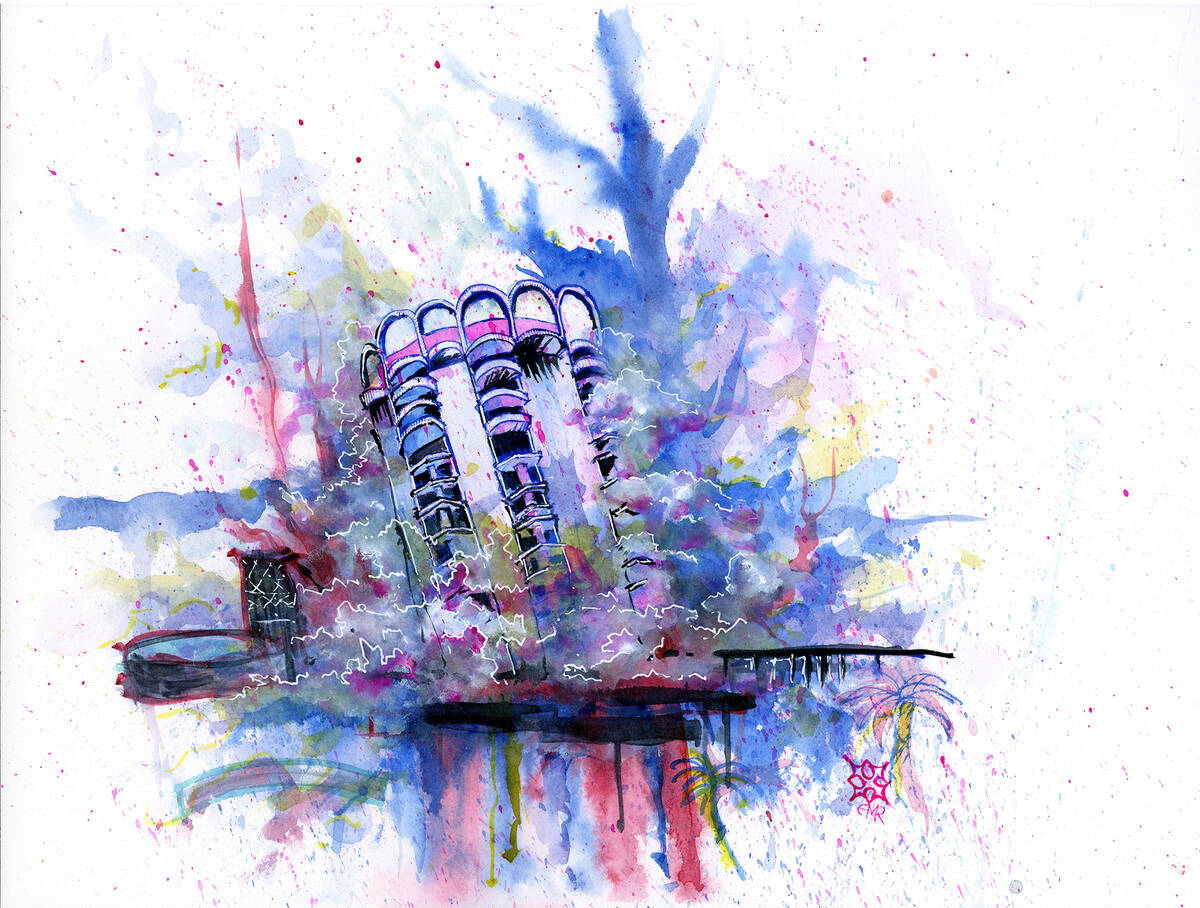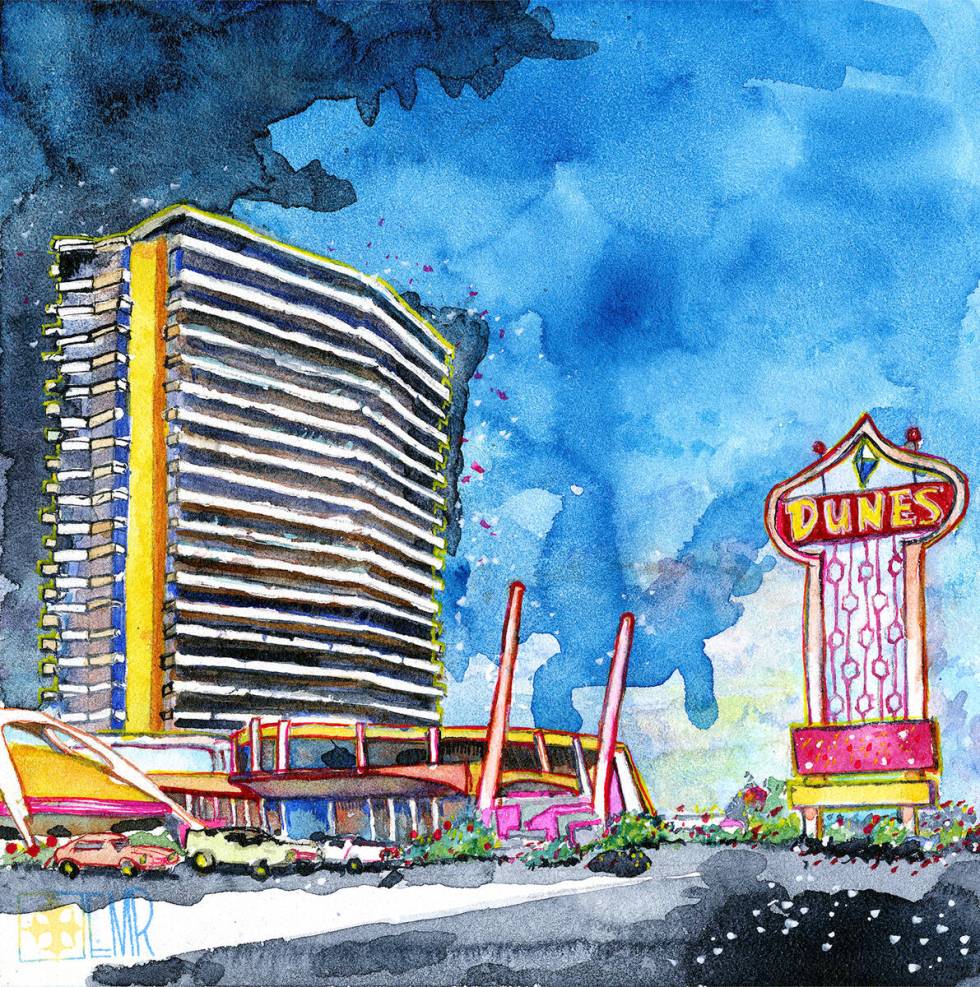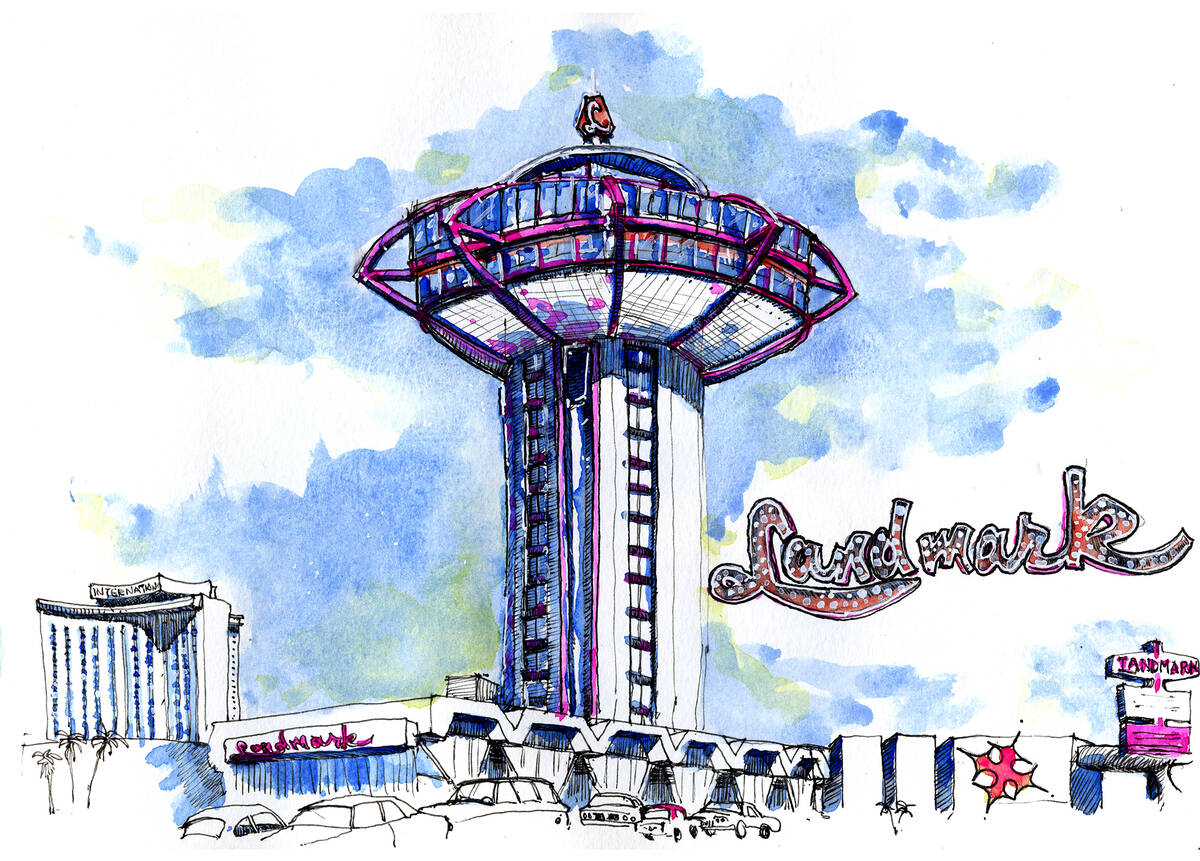In the Shadows of Our Fallen Architecture
In the days leading up to Christmas 1952, a new hotel opened on the Las Vegas Strip. Texas oil tycoon Jake Freedman dreamed of a Las Vegas resort that would attract all the stars of Hollywood. The Sands was designed to be the embodiment of his dream. Within the first eight hours of opening, it had lost over $200,000. The problem, or part of it at least, was the marketing scheme of offering a chamois bag full of silver dollars to all 12,000 of its initial guests. But the losses weren’t as important as what they signified: All those surrendered silver dollars meant that the crowds were coming to the desert; the Sands was a hit.
Freedman’s dream resort soon became the hub for entertainment in Las Vegas. The architecture and clientele cemented it as the home for cool in the nascent desert city. Frank Sinatra, Dean Martin, Sammy Davis Jr. and other members of the Rat Pack made the Sands their own playground throughout the 1950s and ’60s. The Pack’s iconic 1960 caper film, Ocean’s 11, was filmed on the property and used much of the architecture as background. Director Lewis Milestone, who had been making films since 1918, knew the power of a great setting. So did the stars of Hollywood, who flocked to the Sands to cut loose. Middle America was not far behind.
The initial design by Wayne McAllister was highlighted by a 56-foot-tall sign with a slogan declaring the Sands “a place in the sun.” Clearly the Sands was more than just another casino; it was an actual place, an environment that stood for a lifestyle that went well beyond green felt. In 1966, McAllister’s sign was joined by an iconic, cylindrical 500-room tower designed by Martin Stern Jr. The Sands was an American architectural gem from an architectural period that was uniquely American.
So why in 1996, just 19 days before its 44th birthday and a mere 30 years after Stern’s iconic tower was completed, was the Sands imploded? 
Architecture is a communal and democratized art form that relies on previous architectural decisions to create the present. Any architecture student can discuss the importance of studying precedents as a part of the design process. Learning from the history and character of a place is critical to successful architecture. When a city — shepherded and abetted by its landowning power brokers — is so keen to erase its architectural history, where is the precedent to be found? What can an architect draw upon when design is orphaned from its parentage?
Such was my conundrum when I arrived in Las Vegas as a young architect in 2005. The architecture of my city’s past was still alive and thriving as a cultural touchstone — it just didn’t exist anymore. We could talk about it, but we couldn’t see it, in all its three-dimensional concrete glory. Between 1993 and 2007, Las Vegas lost 12 resort properties to implosion. The past was wiped away. With it went the design character, style and roots of a burgeoning Western city.
In fairness, the byproduct of all the demolition pyrotechnics is a Las Vegas Strip that is continually renewed by modern buildings with modern amenities. Each deleted hotel was replaced with a new property with enough rooms to house the population of many rural Nevada communities. The new structures included innovations in public safety, queuing, wayfinding, fire protection, scale adaptation and over-the-top extravagance that were an important part of Las Vegas’ growth. There is so much that architecture, and the world, has gained from what Las Vegas architecture has done and learned over the past three decades. But I can’t help feeling robbed of all the history I will never see.
When my children were small, my parents were still alive. I can’t imagine having started my family without their help and experience. I could touch both the past and the future; I was a synapse between generations. My parents’ presence gave the children an experience of living roots, and of their own rootedness. Even now, with my parents gone, I think about how much I would ask them about shepherding my children into adulthood. But I am forever grateful that the kids had a few years of living contact, and I know that the years in their grandparents’ presence will forever inform who they are and what they will give to the next generation. My relationship with my civic family can never work in the same way: In a city overwhelmingly filled with people who arrived since the Sands came down, none of us will ever know direct contact with the building that has become the center of our civic mythology. 
We have history, of course, the words and facts passed down and shelved in library stacks. We have photographs and even schematics. We have, thank goodness, conversations with the dwindling population of Vegas old-timers, who knew the Sands — and, for that matter, the Dunes, the Landmark, etc. — not only at the end, but also at the beginning. Most great cities develop over a period of time and will show the influence of all their individual history in any given neighborhood or side street. Great American cities like New York were transformed building by building over the course of centuries; erasures were still painful, but the new usually existed alongside the old, and they communicated with one another, as if the old buildings were telling the new ones their secrets. Occasionally, entire areas were hit by a clean sweep generated either by overzealous urban planning or, in the case of some European and Asian cities, war. But those were exceptional circumstances rather than the blithely accepted rule of city-building. In other words, Las Vegas, in so many ways, is exceptional: In a period of less than 20 years —roughly 1993 to 2010 — my city willingly and without much discussion replaced everything. A generation of history, aesthetics, culture and community was surgically removed from the heart of Las Vegas. New buildings and designs were drawn from whole cloth. If the Sands had any “sibling” structures still standing, perhaps I wouldn’t feel this loss as sharply. But that entire layer of history — the synapse between then and now — has been eradicated.
Nothing forced Las Vegas into such a radical transformation. It’s true that other cities have lost vast swaths of their architectural heritage all at once and had to replace them with not only new buildings, but entirely new conceptions of civic space. In many cases, fire has been the historical reason for city rebuilding. London (1666), Moscow (1812), Chicago (1871), San Francisco (1906; earthquake and fire) had no choice but to rebuild from ashes. Las Vegas, on the other hand, dispensed with its old self voluntarily and with great fanfare. The destruction of Las Vegas was accompanied by fireworks, parties and television coverage as our city’s history flashed and then collapsed into embers. There was no period of grieving or memorials built to the disaster that leveled a large portion of this city. There are no memorials to the buildings that were, to the places that lived and breathed and were the lifeblood of this oasis in the desert. Today, the modern Las Vegas vibrates and hums on the foundation of our memories. Our modern buildings reach up into the heavens with their feet squarely on the throat of our past. 
For architects — and, I believe, for the community as a whole — there are design conversations to be had and lessons to be learned from interacting with lost Las Vegas buildings like the Sands. Present design builds upon the sum of its history. In my present, a chasm of understanding isolates me from the designs of early Las Vegas. In my present, the long past and my future have been sacrificed upon the altar of expediency. The last 25 years have extinguished the spark of Las Vegas design of the prior 45.
I think of other great world cities and the modern buildings they have chosen to keep, all of them well past their 44th birthday: Sears Tower in Chicago, the Space Needle in Seattle, the Transamerica Pyramid in San Francisco and Frank Lloyd Wright’s Guggenheim Museum in New York City. It would be blasphemous to propose the destruction of any of these buildings. They are part of the culture and character of the city and the skyline.
Idig into the sandy earth of memory and uncover the treasures of my design ancestors in books and images. Through anecdotes of old-timers — and in a young city like Las Vegas, you don’t have to be so old to be an old-timer — I come to know the vanished generations of our urban design. I ponder old photos and draw the phantoms of our architectural past. As pen meets paper, I imagine the process of creation. The lines form the branches of our civic family tree. A splash of color helps me to commune with the soul of my ancestors. With pen and brush, I bridge the chasm and discover parts of myself in these forms from decades ago.
My day-to-day existence proceeds without parents. My biological parents both passed before I was 40 years old. My architectural “parents”— and aunts, uncles and cousins — were taken from me by the demolition man. Still, I can shine their light into the future. I can choose to learn about them, reflect upon the things they taught and pass these things forward to future generations. In cities, just as in families, we only truly lose what we love when we stop cherishing its memory. ◆
Eric M. Roberts is a Fellow of the American Institute of Architects. Story and art from his book-in-progress, 33 Beats of the Architect’s Heart.












